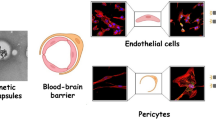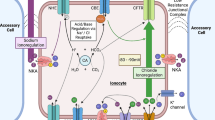Abstract
Preservation of the property of semipermeability of cell appendages in the brain (which is responsible for shrinking) during exposure to hypertonic buffer at various times after death was investigated in experiments on rats. Membranes of the appendages were found to retain the property of semipermeability even 48 h after death. Prefixation of cadaver material in glutaraldehyde has no effect on the sensitivity of the appendage membranes to the osmotic strength of the surrounding solution.
Similar content being viewed by others
Literature Cited
Q. Bone and K. P. Ryan, Histochem. J.,4, 331 (1972).
P. F. Elbers, Biochim. Biophys. Acta,112, 318 (1966).
M. A. Hayat and R. Giaquinta, Tissue and Cell,2, 191 (1970).
G. Hertwig, Z. mirk.-anat. Forsch.,23, 484 (1931).
G. Millonig and V. Marinozzi, in: Advances in Optical and Electron Microscopy, Vol. 2, (1968), p. 251.
G. Millonig, in: Proceedings of the Fifth International Congress on Electron Microscopy, Vol. 2 (1962). p. 8.
Rights and permissions
About this article
Cite this article
Agafonov, V.A. Permeability of membranes of cell appendages in the brain after death. Bull Exp Biol Med 80, 818–821 (1975). https://doi.org/10.1007/BF00809902
Received:
Issue Date:
DOI: https://doi.org/10.1007/BF00809902




